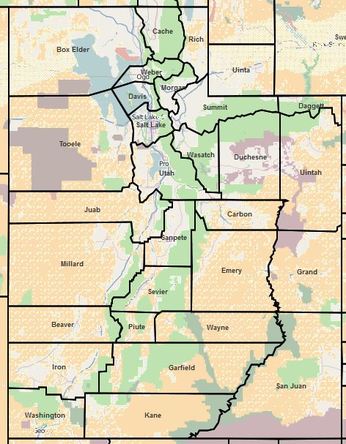|
The US Forest Service today is not the Forest Service our parents and grandparents knew. Below is a Dixie National Forrest map from 1962. The text is more interesting than the map. The first line reads "You, as a citizen of the United States, are joint owner of this mountainous area". It goes on to highlight the recreation, private resorts, wildlife, timber, forage, and energy development in the area. Some quotes from the Forest Service map:
The multiple use philosophy embraced by the forest service in 1962 in no way resembles the forest service management philosophies of today. Unfortunately, many of the policies limit access, reduce recreation opportunities, and eliminate economic activities. If you want a PDF copy of this map, email me at [email protected].  Public lands issues are becoming a polarizing issue once again in the State of Utah. Currently, the Attorney General is pursuing a lawsuit to have federal lands transferred to State control, and the American Lands Council is building support from other western states who agree that federal land control in the West is overreaching. Opponents suggest attempting to change the status quo is a waste of money and will result in developers ruining the beauty and accessibility of the American West. It is helpful to view public lands through a different lens prior to choosing a side in this debate. I found a Dixie National Forest map published by the Department of Agriculture with 1962 dates on it. It starts with an introduction to the June 12, 1960 Multiple-Use and Sustained-Yield law which directs that “the renewable surface resources of the National Forests be developed and administered on a multiple-use and sustained-yield basis…National Forest resources include recreation, forage, timber, water, and wildlife.” It goes on to say that “sustained yield means perpetuating a high-level annual or periodic output of the various renewable resources.” In the early 1960’s, Dixie National Forest forage crop was harvested by 20,000 cattle and 37,000 sheep and the annual growth and harvest of timber was 29 million board feet—enough to build about 2,500 homes. Those calling state control and who simultaneously object to current federal land management policies recognize that there is a difference between the multiple use and sustained basis of the past, and the conservation only mindset of today. Why does the change in position matter? In Utah, significant education funding comes from property taxes. Because the Federal Government owns 62% of Utah and is exempt from property taxes, Utah’s ability to fund education is impaired relative to states with little or no federal ownership. When 20,000 head of cattle were foraging on Dixie National Forest land, it was less expensive to raise cattle. Higher beef prices are partially the result of fewer annual grazing permits on federal lands. Similarly, beetles devastated millions of acres of Utah forest while we imported lumber from Canada. Much of the timber was not harvested because of difficulty obtaining permits on federal land. Further, recreation opportunities are diminished when motorized vehicle restrictions close roads and restrict access to the young, the elderly, and the disabled. Last, and equally frustrating, on September 22nd the Salt Lake Tribune reported the conflicts between the BLM’s Special Agent in Charge and rural county Sheriffs. According to the Tribune, the Sheriffs say, “his intimidating attitude and unwillingness to consult with counties exemplify a ‘culture of arrogance’ that undermines cooperation in Utah’s remote reaches. The public loses, safety is compromised, and tax dollars are wasted.” Public lands will continue to be a polarizing issue. Everyone agrees that the lands should not be exploited, but a conservation only mindset today sacrifices education funding, increases commodity prices, and results in frayed relationships between locals and federal administrators. It is in this context that the Republican Party and its elected officials are pursuing multiple strategies to bring the administration of public lands closer to home. There is no desire to ruin national parks or pollute pristine vistas. The objective is to return to a more balanced approach consistent with the “multiple use and sustained yield basis” that allows all of our citizens to be simultaneous beneficiaries of our vast public lands resources. This article was originally published in The Spectrum as a guest editorial on 9/27/2014. For more information about the economics of a potential lands transfer, please see the study published by a collaborative effort between three state universities: the University of Utah, Bureau of Economic and Business Research; Utah State University; and Weber State University published here: http://bebr.business.utah.edu/page/transfer-federal-lands-state-utah |

 RSS Feed
RSS Feed